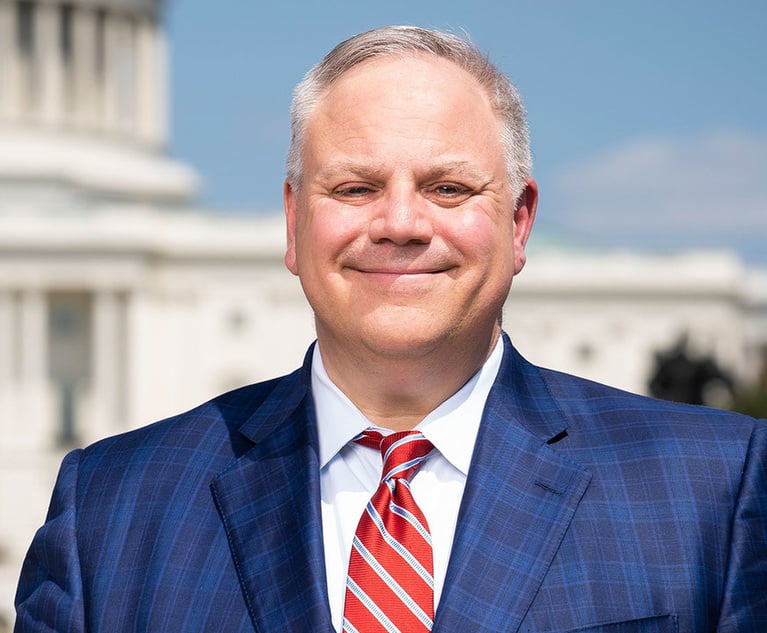Justices, Unanimously, Extend Reach of Federal Age-Discrimination Law
In analyzing the law's definition section, Justice Ruth Bader Ginsburg said the Age Discrimination in Employment Act creates two separate categories: persons engaged in an industry affecting commerce with 20 or more employees; and states or political subdivisions with no specified number of employees.
November 06, 2018 at 11:22 AM
4 minute read
 Justice Ruth Bader Ginsburg. (Photo: Diego M. Radzinschi /ALM)
Justice Ruth Bader Ginsburg. (Photo: Diego M. Radzinschi /ALM)
Updated at 2 p.m.
The U.S. Supreme Court, expanding the reach of the federal law banning age discrimination in the workplace, unanimously ruled Tuesday that state and local political subdivisions of any size must comply.
Justice Ruth Bader Ginsburg wrote the first opinion of the term in Mount Lemmon Fire District v. Guido, argued just five weeks ago. Justice Brett Kavanaugh did not participate in the case, which was argued on the term's first day—Oct. 1. He was not sworn into office until Oct. 5.
Mount Lemmon, an Arizona political subdivision, was sued after it terminated the employment of two of its oldest employees—John Guido, then 46, and Dennis Rankin, 54, both captains. Those employees alleged illegal age discrimination under the Age Discrimination in Employment Act, or ADEA.
Mount Lemmon's lawyer, E. Joshua Rosenkranz of Orrick, Herrington & Sutcliffe, argued in the Supreme Court that the federal law's 20-employee minimum requirement that applies to private employers also applied to state political subdivisions. Because the fire district had fewer than 20 employees, the ADEA did not apply, he said. The justices upheld the U.S. Court of Appeals for the Ninth Circuit's June 2017 ruling. (Watch the appellate oral argument below.)
The justices took the fire district's case to resolve a circuit split between the Ninth Circuit and the Sixth, Seventh, Eighth and Tenth circuits.
In analyzing the law's definition section, Ginsburg said the ADEA creates two separate categories: persons engaged in an industry affecting commerce with 20 or more employees; and states or political subdivisions with no specified number of employees.
“True, reading the ADEA as written to apply to states and political subdivisions regardless of size gives the ADEA, in this regard, a broader reach than Title VII,” she wrote, referring to the nation's major anti-discrimination law. “But this disparity is a consequence of the different language Congress chose to employ.” The better comparison, Ginsburg added, is the Fair Labor Standards Act, “on which many aspects of the ADEA are based” and which also ranks states and political subdivisions as employers, regardless of size.
Ginsburg rejected the fire district's warning that applying the ADEA to small public entities risks limiting vital public services, such as fire protection. She said for 30 years the Equal Employment Opportunity Commission has consistently interpreted the ADEA as the high court has and that most states prohibit age discrimination by political subdivisions of any size.
In a statement Tuesday, Rosenkranz said:
“I recognize Congress did not express itself very clearly. The resulting regime is incoherent. Small employers—public and private—are exempt from discrimination suits on the basis of race, ethnicity, sex, and religion. And small private employers are exempt from discrimination suits on the basis of age. The one thing no one, including the Supreme Court, has ever explained is why Congress would have purposely singled out public employers for harsh treatment for this one type of discrimination in a statute whose purpose was to put them on equal footing with private employers. We fully expect Congress to fix its drafting error and restore parity to public and private entities in a way that makes sense across all discrimination statutes.”
Stanford Law School's Jeffrey Fisher argued on behalf of the terminated employees. Assistant to the Solicitor General Jonathan Bond also argued in support of the employees.
The Supreme Court's ruling is posted below:
Read more:
Court Records in Age Case Reveal Once-Secret Hiring Practices at Google
Stanford Jeffrey Fisher, Veteran SCOTUS Lawyer, Joins O'Melveny
Age Bias Ruling Could Spark 'Extensive' Litigation, Appeals Court Is Warned
Age Discrimination Law Protects Applicants, Not Just Employees: US Appeals Court
This content has been archived. It is available through our partners, LexisNexis® and Bloomberg Law.
To view this content, please continue to their sites.
Not a Lexis Subscriber?
Subscribe Now
Not a Bloomberg Law Subscriber?
Subscribe Now
NOT FOR REPRINT
© 2025 ALM Global, LLC, All Rights Reserved. Request academic re-use from www.copyright.com. All other uses, submit a request to [email protected]. For more information visit Asset & Logo Licensing.
You Might Like
View All
Brownstein Adds Former Interior Secretary, Offering 'Strategic Counsel' During New Trump Term
2 minute read
Weil, Loading Up on More Regulatory Talent, Adds SEC Asset Management Co-Chief
3 minute read
FTC Sues PepsiCo for Alleged Price Break to Big-Box Retailer, Incurs Holyoak's Wrath
5 minute read
Supreme Court Will Hear Religious Parents' Bid to Opt Out of LGBTQ-Themed School Books
Trending Stories
- 1Silk Road Founder Ross Ulbricht Has New York Sentence Pardoned by Trump
- 2Settlement Allows Spouses of U.S. Citizens to Reopen Removal Proceedings
- 3CFPB Resolves Flurry of Enforcement Actions in Biden's Final Week
- 4Judge Orders SoCal Edison to Preserve Evidence Relating to Los Angeles Wildfires
- 5Legal Community Luminaries Honored at New York State Bar Association’s Annual Meeting
Who Got The Work
J. Brugh Lower of Gibbons has entered an appearance for industrial equipment supplier Devco Corporation in a pending trademark infringement lawsuit. The suit, accusing the defendant of selling knock-off Graco products, was filed Dec. 18 in New Jersey District Court by Rivkin Radler on behalf of Graco Inc. and Graco Minnesota. The case, assigned to U.S. District Judge Zahid N. Quraishi, is 3:24-cv-11294, Graco Inc. et al v. Devco Corporation.
Who Got The Work
Rebecca Maller-Stein and Kent A. Yalowitz of Arnold & Porter Kaye Scholer have entered their appearances for Hanaco Venture Capital and its executives, Lior Prosor and David Frankel, in a pending securities lawsuit. The action, filed on Dec. 24 in New York Southern District Court by Zell, Aron & Co. on behalf of Goldeneye Advisors, accuses the defendants of negligently and fraudulently managing the plaintiff's $1 million investment. The case, assigned to U.S. District Judge Vernon S. Broderick, is 1:24-cv-09918, Goldeneye Advisors, LLC v. Hanaco Venture Capital, Ltd. et al.
Who Got The Work
Attorneys from A&O Shearman has stepped in as defense counsel for Toronto-Dominion Bank and other defendants in a pending securities class action. The suit, filed Dec. 11 in New York Southern District Court by Bleichmar Fonti & Auld, accuses the defendants of concealing the bank's 'pervasive' deficiencies in regards to its compliance with the Bank Secrecy Act and the quality of its anti-money laundering controls. The case, assigned to U.S. District Judge Arun Subramanian, is 1:24-cv-09445, Gonzalez v. The Toronto-Dominion Bank et al.
Who Got The Work
Crown Castle International, a Pennsylvania company providing shared communications infrastructure, has turned to Luke D. Wolf of Gordon Rees Scully Mansukhani to fend off a pending breach-of-contract lawsuit. The court action, filed Nov. 25 in Michigan Eastern District Court by Hooper Hathaway PC on behalf of The Town Residences LLC, accuses Crown Castle of failing to transfer approximately $30,000 in utility payments from T-Mobile in breach of a roof-top lease and assignment agreement. The case, assigned to U.S. District Judge Susan K. Declercq, is 2:24-cv-13131, The Town Residences LLC v. T-Mobile US, Inc. et al.
Who Got The Work
Wilfred P. Coronato and Daniel M. Schwartz of McCarter & English have stepped in as defense counsel to Electrolux Home Products Inc. in a pending product liability lawsuit. The court action, filed Nov. 26 in New York Eastern District Court by Poulos Lopiccolo PC and Nagel Rice LLP on behalf of David Stern, alleges that the defendant's refrigerators’ drawers and shelving repeatedly break and fall apart within months after purchase. The case, assigned to U.S. District Judge Joan M. Azrack, is 2:24-cv-08204, Stern v. Electrolux Home Products, Inc.
Featured Firms
Law Offices of Gary Martin Hays & Associates, P.C.
(470) 294-1674
Law Offices of Mark E. Salomone
(857) 444-6468
Smith & Hassler
(713) 739-1250










